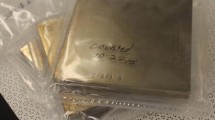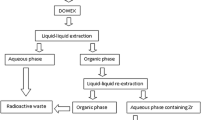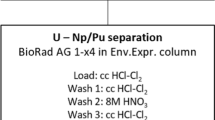Abstract
Radiation detectors used to search for the existence of exceptionally rare phenomena, such as double-beta decay and dark matter interactions, as well as tiny traces of environmental radioactivity, require the elimination of background signals. Modern detection systems created from ultra pure materials and operated deep underground may be sensitive enough to “see” these rare phenomena, but background activity in Pb gamma-ray shielding could still be a critical stumbling block owing to alpha and beta emissions of Pb, Bi, and Po in the mass 210 chain. To minimize the probability of overwhelming activity from Pb, the alpha activity of 210Pb is quantified. However, a reliable quantification procedure that does not require large volumes of chemicals has not yet been established. Two procedures created for this purpose have been tested for the quantification of alpha activity in lead. Both procedures were designed to start with less than 10 g Pb samples to reduce reagents needed and combined precipitation with column separation to isolate 210Pb, followed by alpha spectrometry. One procedure shows promise for obtaining high recoveries and good separation.


Similar content being viewed by others
References
Brodzinski RL (2000) The ‘discovery’ of alpha activity in lead and solder. J Electron Mater 29(10):1294–1298
Alessandro A, Arpesella C, Brofferio C et al (1998) Measurements of internal radioactive contamination in samples of Roman lead to be used in experiments on rare events. Nucl Instrum Methods Phys Res B 142(1):163–172(10)
Miley HS, Brodzinski RL, Reeves JH et al (1995) Achieving low backgrounds in a variety of situations. Superconductivity and particle detection: international workshop. World Scientific, River Edge, NJ, pp 241–256
Leonard DS, Grinberg P, Weber P et al (2008) Systematic study of trace radioactive impurities in candidate construction materials for EXO-200. Nucl Instrum Methods A 591:490–509
Lide DR (ed) (2008) CRC handbook of chemistry and physics, 88th edn. CRC Press/Taylor and Francis, Boca Raton
Fisher Scientific (2009) Nitric acid optima certificate of analysis. http://www.fishersci.com/webapp/wcs/stores/servlet/CofAProcess?catalognumber=A467&lotnumber=1209010&storeId=10001&goToCertificate=YES&goToSearchPageWithBothEntry=NO. Accessed March 2009
Miura T, Hayano K, Nakayama K (1999) Determination of 210Pb and 210Po in environmental samples by alpha ray spectrometry using an extraction chromatography resin. Anal Sci 15:23
Radiological and Chemical Science Group (1999) Analytical procedure manual. Radiological and Chemical Science Group, Richland, WA, pp 83–84
Glover S, Filby R, Clark S, Grytdal S (1998) Optimization and characterization of a sulfate based electrodeposition method for alpha-spectroscopy of actinide elements using chemometric analysis. J Radioanal Nucl Chem 234:213–218
Acknowledgments
This work was supported by the U.S. Department of Energy (DOE) under Contract No. DE-AC06-76RLO 1830. Pacific Northwest National Laboratory is operated for the DOE by Battelle Memorial Institute.
Author information
Authors and Affiliations
Corresponding author
Rights and permissions
About this article
Cite this article
Miley, S.M., Payne, R.F., Schulte, S.M. et al. Polonium–lead extractions to determine the best method for the quantification of clean lead used in low-background radiation detectors. J Radioanal Nucl Chem 282, 869–872 (2009). https://doi.org/10.1007/s10967-009-0319-9
Received:
Accepted:
Published:
Issue Date:
DOI: https://doi.org/10.1007/s10967-009-0319-9




